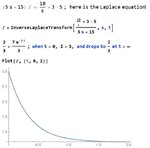electronicsman
Full Member level 5

Follow along with the video below to see how to install our site as a web app on your home screen.
Note: This feature may not be available in some browsers.








The equation 39 is View attachment 157138 and the equation 41 is View attachment 157139. This is my attempt using equation 39 and making current i through R as 0, I get
After 1.5s the fuse blows.Code:L*di/dt = E; i = E/L*t ; 3 = 10/5*t; t = 1.5s;



But this is against the property of the inductor. The current in an inductor cannot change immediately it raises exponentially.The coil has no resistance to the current, so the fuse exceeds the 3 amp limit immediately and blows.
Ratch

But why "exponentially"?But this is against the property of the inductor. The current in an inductor cannot change immediately it raises exponentially.

Hi,
It means a linear rise rate of current.
Example :
2A after 1s --> 2A/1s = 2A/s
4A after 2s --> 4A/2s = 2A/s
6A after 3s --> 6A/3s = 2A/s
8A after 4s --> 8A/4s = 2A/s
...the rise rate is constant 2A/s
With a real coil there are two major issues making it nonlinear:
* coil saturation
* series resistance
Klaus
I think it should beL = V x t / I

This is for true coil with series R....The reason i said exponential because of the current equation in the inductor
I never assumed constant current.If you assume constant current then dI/dt will be 0.




According to problem text, the switch is closed at t=0. According to usual understanding, the initial condition has to be calculated with open switch. Hence current starts linearly from zero, as calculated in post #6.
In SPICE simulator terms, we would specify Vinitial=0, Von=10, tdelay=0.
But this is against the property of the inductor. The current in an inductor cannot change immediately it raises exponentially.

Correct, no time constant,Without resistance, there is no finite time-constant
